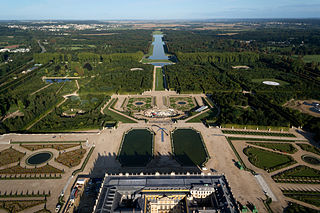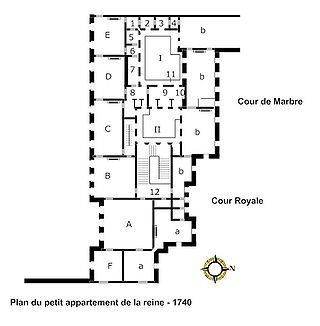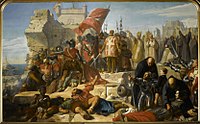
The Tuileries Palace was a royal and imperial palace in Paris which stood on the right bank of the Seine, directly in front of the Louvre. It was the Parisian residence of most French monarchs, from Henry IV to Napoleon III, until it was burned by the Paris Commune in 1871.

Raymond du Puy (1083–1160) was a knight from Dauphiné in France and the second Grand Master of the Knights Hospitaller, also known as the Order of St. John of Jerusalem, from around 1121 until 1160. Officially, he succeeded Blessed Gerard, the founder of the Order, as Grand Master. While traditionally cited as the direct successor upon Gerard's death in 1118 or 1120, his assumption of the magisterium was in 1121 or 1123 after one or two interim superiors, Pierre de Barcelona and Boyant Roger. Raymond divided the membership of the Order into clerical, military, and serving brothers and established the first significant Hospitaller infirmary near the Church of the Holy Sepulchre in Jerusalem.

The Grand Trianon is a French Baroque style château situated in the northwestern part of the Domain of Versailles in Versailles, France. It was built at the request of Louis XIV of France as a retreat for himself and his maîtresse-en-titre of the time, the Marquise de Montespan, and as a place where he and invited guests could take light meals (collations) away from the strict etiquette of the royal court. The Grand Trianon is set within its own park, which includes the Petit Trianon.

Gilbert of Assailly was the fifth Grand Master of the Knights Hospitaller, serving from 1162 or 1163 to 1170, when he was deposed. As Grand Master, he succeeded Auger de Balben. Nevertheless, most sources list him as the fifth, rather than fourth, Grand Master and this biography continues that tradition, with the exception being Delaville Le Roulx' work. He was succeeded by Gastone de Murols. Gilbert encouraged Amalric of Jerusalem in his unsuccessful invasion of Egypt, leaving the Order in debt and causing the reexamination of its military role.
Alain Demurger is a French historian, and a leading specialist of the history of the Knights Templar and the Crusades.

The Gardens of Versailles occupy part of what was once the Domaine royal de Versailles, the royal demesne of the château of Versailles. Situated to the west of the palace, the gardens cover some 800 hectares of land, much of which is landscaped in the classic French formal garden style perfected here by André Le Nôtre. Beyond the surrounding belt of woodland, the gardens are bordered by the urban areas of Versailles to the east and Le Chesnay to the north-east, by the National Arboretum de Chèvreloup to the north, the Versailles plain to the west, and by the Satory Forest to the south.

The grand appartement de la reine is the Queen's grand apartment of the Palace of Versailles.

The petit appartement du roi of the Palace of Versailles is a suite of rooms used by Louis XIV, Louis XV, and Louis XVI. Located on the first floor of the palace, the rooms are found in the oldest part of the palace dating from the reign of Louis XIII. Under Louis XIV, these rooms housed the king's collections of artworks and books, forming a museum of sorts. Under Louis XV and Louis XVI, the rooms were modified to accommodate private living quarters. At this time, the rooms were transformed and their decoration represent some of the finest extant examples of the Louis XV style and Louis XVI style at Versailles.

The appartement du roi or King's Apartment is the suite of rooms in the Palace of Versailles that served as the living quarters of Louis XIV. Overlooking the Marble Court, these rooms are situated in the oldest part of the chateau in rooms originally designated for use by the queen in Louis XIII's chateau. Owing largely to the discomfort of the grand appartement du roi and to the construction of the Hall of Mirrors, Louis XIV began to remodel these rooms for his use shortly after the death of Maria Theresa in 1684. The appartement du roi evolved to become the everyday working quarters for Louis XV and Louis XVI.

The petit appartement de la reine is a suite of rooms in the Palace of Versailles. These rooms, situated behind the grand appartement de la reine, and which now open onto two interior courtyards, were the private domain of the Queens of France, Maria Theresa of Spain, Marie Leszczyńska, and Marie-Antoinette, as well as of the duchesse de Bourgogne as dauphine.

The present chapel of the Palace of Versailles is the fifth in the history of the palace. These chapels evolved with the expansion of the château and formed the focal point of the daily life of the court during the Ancien Régime.

The Royal Opera of Versailles is the main theatre and opera house of the Palace of Versailles. Designed by Ange-Jacques Gabriel, it is also known as the Théâtre Gabriel. The interior decoration by Augustin Pajou is constructed almost entirely of wood, painted to resemble marble in a technique known as faux marble. The excellent acoustics of the opera house are at least partly due to its wooden interior.

The Palace of Versailles is a royal château in Versailles, in the Île-de-France region of France. When the château was built, Versailles was a country village; today, however, it is a suburb of Paris, some 20 kilometres southwest of the French capital. The court of Versailles was the centre of political power in France from 1682, when Louis XIV moved from Paris, until the royal family was forced to return to the capital in October 1789 after the beginning of the French Revolution. Versailles is therefore famous not only as a building, but as well as a symbol of the system of absolute monarchy of the Ancien Régime.

Guy II of Dampierre was constable of Champagne, and Lord of Dampierre, Bourbon and Montluçon. He was the only son of William I of Dampierre, Lord of Dampierre, and Ermengarde of Mouchy. William I of Dampierre was the son of Guy I, Lord of Dampierre and Viscount of Troyes, and Helvide de Baudémont.

The Cour Carrée is one of the main courtyards of the Louvre Palace in Paris. The wings surrounding it were built gradually, as the walls of the medieval Louvre were progressively demolished in favour of a Renaissance palace.
Georges Tate was a French historian and professor of ancient history and archaeology at the Versailles Saint-Quentin-en-Yvelines University, Doctor of Arts and correspondent of the Académie des Inscriptions et Belles-Lettres. He was a specialist on the history of late antiquity and Early Middle Ages in Near East.

Eugène Goyet, was a French artist. Beginning in 1827 his work was regularly selected for exhibition in the annual Paris Salon. He achieved his greatest success as a painter of religious subjects, with his paintings of Christ and various saints installed in churches and public buildings across France. A successful portrait painter, his most prestigious commission was his 1847 portrait of Pope Pius IX. He was the son of self-taught artist Jean-Baptiste Goyet, and husband of the pastel portrait artist Zoé Goyet.

The Musée de l'Histoire de France is a museum that was created by King Louis Philippe I in the Palace of Versailles and opened in 1837. At the time, it represented an ambitious project of national reconciliation between the hitherto competing narratives of the French monarchy and the French Revolution, to which Louis-Philippe devoted significant personal attention. Whereas it gradually faded in importance as a museum in the later 19th century, its lavish historicist decoration remains a major exemplar of the art of France's July Monarchy.



















